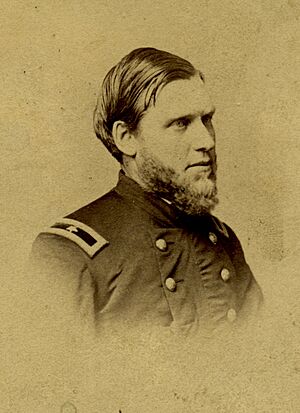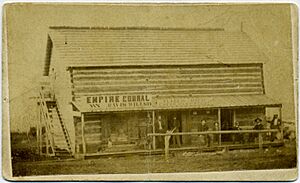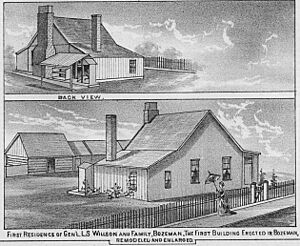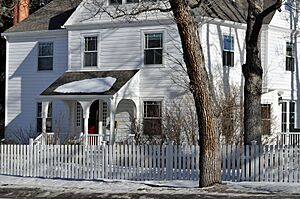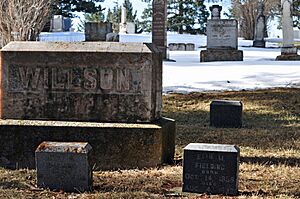Lester S. Willson facts for kids
Quick facts for kids
Lester Sebastion Willson
|
|
|---|---|
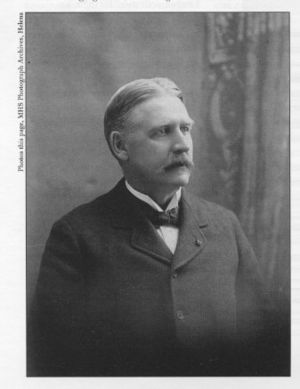
Lester Sebastion Willson, c. 1898
|
|
| Birth name | Lester Sebastion Willson |
| Born | June 16, 1839 Canton, New York |
| Died | January 26, 1919 (aged 79) Bozeman, Montana |
| Buried |
Sunset Hills Cemetery, Bozeman, Montana
(45°40′31.93″N 111°01′35.38″W / 45.6755361°N 111.0264944°W) |
| Service/ |
U.S. Army Volunteers |
| Years of service | 1861-1865 |
| Rank | Brevet Brigadier General |
| Unit | 60th New York Volunteers |
| Battles/wars | Battle of Atlanta |
| Relations | Emma D. Weeks (Wife) Fred Fielding Willson (Son) |
| Other work | Montana Merchant and State Legislator |
Lester Sebastion Willson (June 16, 1839 – January 26, 1919) was an important figure in American history. He was a brave officer in the U.S. Civil War, serving in the Union Army. After the war, he became a successful businessman and politician in Bozeman, Montana. He married Emma D. Weeks in New York in 1869 and lived in Bozeman until he passed away.
Contents
Early Life and Education
Lester Willson was born in Canton, New York on June 16, 1839. His parents were Ambrose and Julia Willson. He was one of seven children and had two brothers, Davis and George. Davis later played a big part in Lester's business career in Montana.
Lester went to public schools in Canton. He also graduated from a well-known Academy. After school, he worked as a clerk for two years. In 1861, he decided to join the Union Army.
Civil War Service
Willson joined Company A, Sixtieth New York Volunteers, in August 1861. He quickly moved up in rank. He became a second sergeant in September 1861. By October 1862, he was a lieutenant. He became a first lieutenant and adjutant (a staff officer who helps a commander) in November 1862.
He was offered a captain's role but turned it down at first. He became a captain in August 1864. Later, he was promoted to lieutenant-colonel in October 1864 and colonel in May 1865. Willson left his regiment in July 1865 as a colonel. In March 1867, he was given the honorary rank of brigadier-general. This was for his brave service under General Sherman, which helped lead to the fall of Atlanta, Georgia.
Major Campaigns
During the winter of 1861-62, Willson helped guard the Baltimore and Ohio Railroad. He also fought in campaigns in Virginia. These were under generals Nathaniel P. Banks and John Pope. He fought in the Battle of Antietam in September 1862.
In May 1863, he was badly wounded at the Battle of Chancellorsville in Virginia. He returned to duty in September 1863. He served under General Joseph Hooker. His corps moved west to help the Army of the Cumberland near Chattanooga, Tennessee. There, Willson fought in several battles. These included Wauhatchie, Lookout Mountain, Missionary Ridge, Peavine Creek, and Ringgold Gap.
In 1864-65, he served under General William Sherman. He took part in the Chattanooga campaign, the Atlanta Campaign, the Savannah Campaign, and the Carolinas Campaign.
As an aide and assistant adjutant-general, Willson was part of important events. In Atlanta, his regiment, the 60th New York Volunteers, helped raise the Union flag over the city hall. In Savannah, he was the first officer to enter the city with his regiment. He received the city's surrender from its mayor. His regiment then protected the citizens from looting.
General Sherman trusted Willson with difficult and dangerous tasks. Major General George S. Greene praised Willson as a very loyal and smart officer. He also called Willson's regiment "one of the best in the service."
Post-War Service
After the war, Willson was a lieutenant colonel. Because of his good service, he was made assistant quartermaster-general of the New York State Militia. He held the rank of colonel. For two years, he managed post-war issues. This included dealing with railroads for troop and supply transport. He also handled state supplies.
Moving West to Montana
Lester Willson worked with his cousin Charles Rich and army friend Loren W. Tuller. In December 1865, he heard a speech about the western U.S. This made him want to move west. He convinced his co-workers to go to Montana. They planned to start a business there.
Lester could not leave his job in New York right away. So, he invested in the business. He also asked his younger brother Davis to join Rich and Tuller. In May 1866, Davis Willson, Rich, and Tuller reached Omaha, Nebraska. They bought over $5000 worth of supplies and goods. They then traveled overland to Bozeman, Montana.
Their journey took them along the Great Platte River Road to Fort Laramie. Then they went northwest along the Bozeman Trail. They arrived safely in Bozeman on September 2, 1866. They had little trouble with Native American tribes. They ran a successful store from a tent for two months. By the end of 1866, they had a rented cabin on main street. Their sign read: "Tuller and Rich - Cheap Cash Store." Davis also opened a corral (an enclosure for animals) called "Empire Corral." Their business grew as they sent supplies to mining towns like Bannack and Virginia City, Montana.
By spring 1867, Lester Willson had met Emma D. Weeks, who would become his wife. He also finished his important work for the New York State Militia. He left his job in March 1867 to focus on business in Montana.
Montana Business Leader
Lester Willson left New York in April 1867. He took an easier route to Bozeman. The Bozeman Trail was closed due to conflicts. So, Lester traveled by Union Pacific train to Platte City, Missouri. From there, stagecoaches took him to Denver, Colorado, Salt Lake City, Utah, and then to Virginia City, Montana. He met the Governor of Montana Territory, Thomas Francis Meagher, in Virginia City. He arrived in Bozeman on May 22, 1867.
He became an active partner in the mercantile (trading) business. The business was doing very well. This was partly because Fort Ellis was being built near town. In January 1868, he went back to New York and proposed to Emma D. Weeks. By May, he was back in Bozeman helping with the business.
In January 1869, Willson returned to Albany, New York to marry Emma D. Weeks on March 2, 1869. He brought her and her piano back to Bozeman. They traveled by steamboat on the Missouri River to Fort Benton, Montana. They were back in Bozeman by mid-May 1869. They moved into a remodeled cabin. It was one of the nicest homes in Bozeman at the time.
Tuller left the business in 1868, and Davis Willson left in 1870. Davis later became a Presbyterian minister. Lester Willson sold "The Willson Company" in 1914. This was five years before he died.
In August 1870, Lester and Emma hosted the civilian members of the Washburn–Langford–Doane Expedition for dinner. This was the night before they left on their famous trip to Yellowstone.
Willson was also a board member for the first executive board of the Agricultural College of Montana. This college was started in 1893.
In 1882, Willson helped start one of the first banks in the county. It was called the Gallatin Valley National Bank. The bank failed during the Panic of 1893 and never reopened.
Montana Political Career
While in New York, Willson became active in the Union Party (which was like the Republican Party). He brought his political interest with him to Montana. Soon after arriving in Bozeman, Willson helped start a Bozeman chapter of the Union League. This was a patriotic society that supported Republicans. He hoped Republicans would soon lead Montana politics.
Willson became an elector for the Union Party in the 1867 federal elections. In September 1868, he won a seat in the Montana Territorial Legislature. He represented Gallatin County, Montana.
Willson was a Mason and a member of Bozeman Lodge No. 18. He was also a founding member of the William English Post No. 10, Grand Army of the Republic. He was a department commander for Montana. Willson also belonged to the Military Order of the Loyal Legion of the United States in New York. From 1883 to 1886, he served as territorial quartermaster-general. He held the rank of brigadier-general.
Legacy and Family
In 1886, Lester and Emma built a home at 504 Central Ave in Bozeman. This house still stands today on Willson Avenue. After Lester's death, the city renamed Central Avenue to Willson Avenue in his honor.
Lester and Emma Willson had three children. Only one, Fred Fielding Willson, lived to adulthood. Fred Willson became a famous architect in Bozeman. He designed many buildings that are still standing today. He designed the Gallatin County High School. This building was later named Willson School in his honor when it became a middle school.
Lester Willson died on January 26, 1919. He is buried in the Willson family plot at Sunset Hills Cemetery in Bozeman, Montana.
Images for kids


